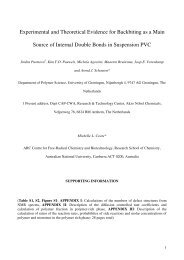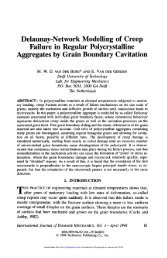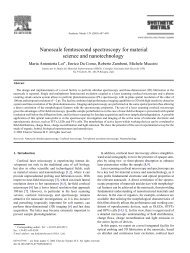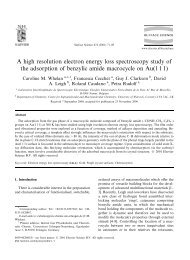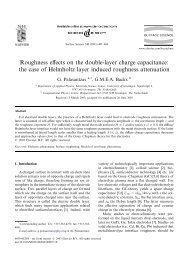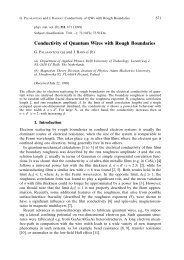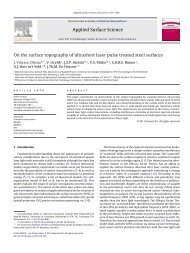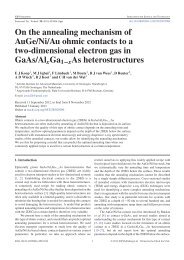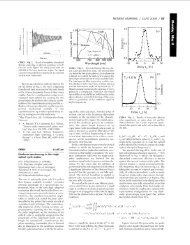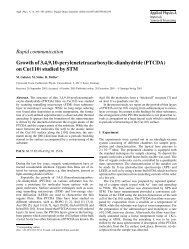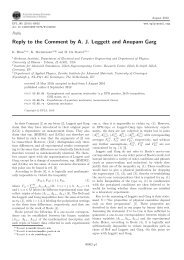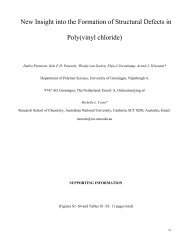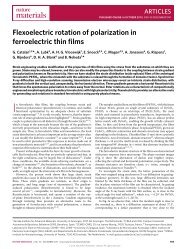Double-layered Aurivillius-type ferroelectrics with magnetic moments
Double-layered Aurivillius-type ferroelectrics with magnetic moments
Double-layered Aurivillius-type ferroelectrics with magnetic moments
You also want an ePaper? Increase the reach of your titles
YUMPU automatically turns print PDFs into web optimized ePapers that Google loves.
Materials Research Bulletin 45 (2010) 546–550<br />
Contents lists available at ScienceDirect<br />
Materials Research Bulletin<br />
journal homepage: www.elsevier.com/locate/matresbu<br />
<strong>Double</strong>-<strong>layered</strong> <strong>Aurivillius</strong>-<strong>type</strong> <strong>ferroelectrics</strong> <strong>with</strong> <strong>magnetic</strong> <strong>moments</strong><br />
A.B. Missyul a, *, I.A. Zvereva a , T.T.M. Palstra b , A.I. Kurbakov c<br />
a Department of Chemistry, Saint-Petersburg State University, 198504, Universitetskiy pr., 26, St.-Petersburg, Russia<br />
b Solid State Chemistry Laboratory, Zernike Institute for Advanced Materials, University of Groningen, 9747AG Groningen, The Netherlands<br />
c Petersburg Nuclear Physics Institute RAS, 188300 Gatchina, St.-Petersburg region, Russia<br />
ARTICLE<br />
INFO<br />
ABSTRACT<br />
Article history:<br />
Received 8 October 2009<br />
Received in revised form 7 January 2010<br />
Accepted 1 February 2010<br />
Available online 6 February 2010<br />
Keywords:<br />
A. Ceramics<br />
B. Chemical synthesis<br />
C. Neutron scattering<br />
C. X-ray diffraction<br />
D. Ferroelectricity<br />
We have synthesized the double-layer <strong>Aurivillius</strong> phase Bi 2 LnNbTiO 9 where Ln = Nd–Gd, Bi. All<br />
compounds adopt the orthorhombic polar space group A2 1 am. The <strong>magnetic</strong> Ln-ion occupies the<br />
cuboctahedral position in the middle of the perovskite double-layer, and thus controls the octahedral tilt<br />
of the perovskite block. This tilt modifies the ferroelectric displacement of the (Nb,Ti) towards the<br />
octahedral faces. This provides a mechanism to systematically modify the polarization. Mn-substitution<br />
on the (Nb,Ti) site for Ln = Bi is homogeneous up to x = 0.2. The <strong>magnetic</strong> <strong>moments</strong> of Ln do not order<br />
down to 5 K.<br />
ß 2010 Elsevier Ltd. All rights reserved.<br />
1. Introduction<br />
Modern technology makes use of materials <strong>with</strong> extraordinary<br />
electrical and <strong>magnetic</strong> properties. The perovskite-<strong>type</strong> ceramics<br />
take a prominent position. Perovskites are built from corner<br />
sharing octahedra which form a three-dimensional structure.<br />
They may contain most of the metals in different oxidation<br />
states and form solid solutions allowing to create materials <strong>with</strong><br />
different properties. This allows to tune their functionality<br />
including magnetism or ferroelectricity. Related materials are<br />
<strong>layered</strong> perovskite-like compounds such as Ruddlesden–Popper<br />
[1], <strong>Aurivillius</strong> [2] or Dion–Jacobson phases [3]. Here, single or<br />
multiple perovskite blocks are separated by layers of ions or<br />
different blocks.<br />
One of the interesting properties observed for perovskites is<br />
multiferroism. Multiferroics are materials in which two or all three<br />
of the properties ferroelectricity, ferromagnetism, and ferroelasticity<br />
occur in the same phase [4]. Due to practical reasons the<br />
meaning of the term ‘multiferroism’ has changed and now it often<br />
means simultaneous occurrence of ferroelectricity and any <strong>type</strong> of<br />
<strong>magnetic</strong> ordering (ferro-, antiferro- or ferrimagnetism). Specific<br />
device applications that have been suggested for such materials<br />
include multiple-state memory elements, electric-field-controlled<br />
* Corresponding author. Tel.: +7 812 4284051; fax: +7 812 4286939.<br />
E-mail address: lab2193@gmail.com (A.B. Missyul).<br />
ferro<strong>magnetic</strong> resonance devices, and transducers <strong>with</strong> <strong>magnetic</strong>ally<br />
modulated piezoelectricity.<br />
The first multiferroic compound, Ni 3 B 7 O 13 I was discovered in<br />
1966 [5] but until now the number of multiferroics is very small.<br />
Theoretical analysis by Hill [6] shows that in the ABO 3 perovskites<br />
general demands for ferroelectricity and ferromagnetism are<br />
opposite: the electron configuration of the B ion should be d 0 for<br />
<strong>ferroelectrics</strong> and d n (n 6¼ 0) for <strong>magnetic</strong> properties. Conventionally,<br />
there are two ways to solve this problem: one can either<br />
synthesize solid solutions of ferroelectric and <strong>magnetic</strong> phases or<br />
use subtle effects originating from the A ion. Recently various novel<br />
approaches have been suggested [7].<br />
Layered perovskite-like oxides were not considered as possible<br />
multiferroics. However, most of the <strong>Aurivillius</strong> phases are<br />
ferroelectric and substitution of the non-<strong>magnetic</strong> ions by<br />
<strong>magnetic</strong> ones in these phases might lead to the formation of<br />
multiferroic compounds. The present article deals <strong>with</strong> two<br />
possible ways to prepare such compounds: the substitution of<br />
Bi 3+ for Ln 3+ and Ti 4+ for Mn 4+ in Bi 3 NbTiO 9 . The resulting<br />
compositions Bi 2 LnNbTiO 9 and Bi 3 NbTi 1 x Mn x O 9 as well as mixed<br />
Bi 2 LnNbTi 1 x Mn x O 9 potentially show both ferroelectricity and<br />
<strong>magnetic</strong> ordering.<br />
Bi 2 LnNbTiO 9 phases were thoroughly investigated only for<br />
Ln = La [8]. Bi 2 NdNbTiO 9 , Bi 2 SmNbTiO 9 and Bi 2 GdNbTiO 9 were<br />
synthesized in 2003 [9] but only their lattice parameters and<br />
ferroelectric properties were determined, while their <strong>magnetic</strong><br />
properties and exact crystal structure, including site occupancies,<br />
remain unknown.<br />
0025-5408/$ – see front matter ß 2010 Elsevier Ltd. All rights reserved.<br />
doi:10.1016/j.materresbull.2010.02.002
A.B. Missyul et al. / Materials Research Bulletin 45 (2010) 546–550 547<br />
Table 1<br />
Crystal data and structural parameters of Bi 2 LnNbTiO 9 as refined from X-ray data.<br />
Ion Position x y z U iso<br />
Bi 2 NdNbTiO 9 Bi 3+ 8b 0 0.7405(4) 0.69904(4) 0.02766(19)<br />
a = 5.41892(5) Nd 3+ 4a 0.9919(13) 0.2558(8) 0 0.00581(34)<br />
b = 5.42058(5) Nb 5+ 8b 0.0104(12) 0.2521(13) 0.58697(7) 0.0030(5)<br />
c = 24.87409(26) Ti 4+ 8b 0.0104(12) 0.2521(13) 0.58697(7) 0.0030(5)<br />
R wp = 9.40% O 2 4a 0.068(4) 0.709(6) 0 0.01 *<br />
R p = 6.94% O 2 8b 0.056(3) 0.261(5) 0.6570(4) 0.01 *<br />
O 2 8b 0.244(12) 0.499(24) 0.2581(7) 0.01 *<br />
O 2 8b 0.266(8) 0.484(6) 0.5684(5) 0.01 *<br />
O 2 8b 0.324(4) 0.035(4) 0.5886(5) 0.01 *<br />
Bi 2 SmNbTiO 9 Bi 3+ 8b 0 0.7388(4) 0.69902(4) 0.01849(16)<br />
a = 5.40011(6) Sm 3+ 4a 0.9970(23) 0.2521(8) 0 0.0022(3)<br />
b = 5.40283(7) Nb 5+ 8b 0.0067(21) 0.2461(12) 0.58709(7) 0.01 *<br />
c = 24.86290(25) Ti 4+ 8b 0.0067(21) 0.2461(12) 0.58709(7) 0.01 *<br />
R wp = 9.70% O 2 4a 0.080(4) 0.724(7) 0 0.01 *<br />
R p = 7.14% O 2 8b 0.042(4) 0.283(4) 0.6563(4) 0.01 *<br />
O 2 8b 0.248(26) 0.500(11) 0.2542(9) 0.01*<br />
O 2 8b 0.2342(9) 0.512(9) 0.5738(5) 0.01 *<br />
O 2 8b 0.331(4) 0.068(4) 0.5944(6) 0.01 *<br />
Bi 2 EuNbTiO 9 Bi 3+ 8b 0 0.7369(5) 0.69897(4) 0.0287(6)<br />
a = 5.40124(27) Eu 3+ 4a 0.9796(20) 0.2527(10) 0 0.0022(9)<br />
b = 5.39046(27) Nb 5+ 8b 0.0176(17) 0.2492(14) 0.58692(9) 0.0001(10)<br />
c = 24.8568(12) Ti 4+ 8b 0.0176(17) 0.2492(14) 0.58692(9) 0.0001(10)<br />
R wp = 9.32% O 2 4a 0.052(8) 0.698(7) 0 0.01 *<br />
R p = 7.02% O 2 8b 0.049(5) 0.278(5) 0.6566(5) 0.01 *<br />
O 2 8b 0.250(13) 0.490(10) 0.2483(12) 0.01 *<br />
O 2 8b 0.192(5) 0.508(7) 0.5679(6) 0.01 *<br />
O 2 8b 0.291(7) 0.074(5) 0.5881(6) 0.01 *<br />
Bi 2 GdNbTiO 9 Bi 3+ 8b 0 0.7361(4) 0.69875(4) 0.02605(24)<br />
a = 5.38249(9) Gd 3+ 4a 0.9980(18) 0.2519(11) 0 0.0023(4)<br />
b = 5.39664(11) Nb 5+ 8b 0.0184(13) 0.2506(15) 0.58688(9) 0.0026(7)<br />
c = 24.8283(5) Ti 4+ 8b 0.0184(13) 0.2506(15) 0.58688(9) 0.0026(7)<br />
R wp = 9.44% O 2 4a 0.089(4) 0.733(9) 0 0.01 *<br />
R p = 7.28% O 2 8b 0.048(4) 0.279(6) 0.6572(5) 0.01 *<br />
O 2 8b 0.246(18) 0.504(31) 0.2546(12) 0.01 *<br />
O 2 8b 0.263(6) 0.443(5) 0.5662(6) 0.01 *<br />
O 2 8b 0.341(4) 0.043(4) 0.5897(7) 0.01 *<br />
* Thermal parameters fixed during the refinement.<br />
2. Experimental<br />
All materials were synthesized from stoichiometric quantities<br />
of Bi 2 O 3 (99.99%), TiO 2 (99.9%), MnO 2 (99.9%), and Ln 2 O 3 (99.9%).<br />
Initial oxides were ground in an agate mortar, pelletized and<br />
heated in an alumina crucible. The Bi 2 LnNbTiO 9 phases were<br />
synthesized by sequential heating at 900 and 1100 8C for 3 h at<br />
each temperature. The reaction mixture for Bi 3 NbTi 1 x Mn x O 9<br />
melts and reacts <strong>with</strong> crucibles at high temperature so heating was<br />
performed at 900 8C for 5 h.<br />
X-ray diffraction was performed on a Bruker D8 diffractometer<br />
using CuKa radiation. Rietveld refinement was performed <strong>with</strong> the<br />
GSAS suite of programs [10]. Powder diffraction patterns for the<br />
refinement were obtained in the range 2u = 10–1358 <strong>with</strong> 0.028<br />
step. Step time was 9 s. Neutron diffraction experiments were<br />
performed in the Petersburg Nuclear Physics Institute, using the<br />
WWR-M reactor, beam line 9a. The wavelength of the monochromated<br />
neutron beam was 1.85 Å, the diffraction data were<br />
obtained for 2u = 4–1438 <strong>with</strong> 0.18 step.<br />
3. Results and discussion<br />
The synthesis of Bi 2 LnNbTiO 9 was attempted for Ln = Nd, Sm,<br />
Eu, Gd, Dy, Ho, and Er. Pure <strong>Aurivillius</strong> phases were obtained for<br />
Ln = Nd–Gd while for smaller lanthanides impurities <strong>with</strong> pyrochlore<br />
and Bi 4 Ti 3 O 12 structures were observed. Previous investigations<br />
concerning the substitution of Bi 3+ for Ln 3+ in triple-<strong>layered</strong><br />
<strong>Aurivillius</strong> Bi 4 Ti 3 O 12 [11] also displayed such a limit. The exact<br />
composition of the impurity phases is difficult to determine: the<br />
Bi 4 Ti 3 O 12 -phase might contain a certain amount of Ln on the Bi<br />
positions while the pyrochlore phases in such systems are strongly<br />
non-stoichiometric.<br />
Rietveld refinement was carried out for Bi 2 LnNbTiO 9 (Ln = Nd,<br />
Sm, Eu, Gd). Evaporation of Bi 2 O 3 at high temperatures results in<br />
appearing of traces of pyrochlore-<strong>type</strong> impurities, so an interval<br />
corresponding to the strongest pyrochlore peak (approximately 28–<br />
28.68) was excluded during all calculations. All compounds were<br />
refined in the space group A2 1 am. As the position of the origin along<br />
the x axis is not defined in this space group, it was fixed by assuming<br />
that the x coordinate of the Bi 3+ ion is equal to zero. The thermal<br />
factors of the oxygen atoms were fixed at the value 0.01 and not<br />
refined. The results are presented in Table 1. The structure of<br />
Bi 2 NdNbTiO 9 is shown in Fig. 1. The refinement was also carried out<br />
using the centrosymmetric space group Pmcb that was proposed by<br />
Nalini et al. [8] for Bi 2 LaNbTiO 9 . However, in this case the results<br />
were not satisfactory for the following reasons. The y coordinates of<br />
(Nb,Ti) have an error twice larger than in case of the space group<br />
A2 1 am. The thermal parameters of the oxygen ions are unacceptably<br />
large (U iso = 0.8). Finally, the final profile factors were significantly<br />
larger (up to R p = 10.93 for Bi 2 SmNbTiO 9 ). This indicates that the<br />
non-centrosymmetric space group A2 1 am describes the structure<br />
better than the centrosymmetric space group Pmcb.<br />
The lattice parameters of Bi 2 LnNbTiO 9 for Ln = Nd–Gd, compared<br />
<strong>with</strong> Ln = La, from Ref. [8] are shown in Fig. 2. The observed<br />
decrease in lattice parameters reflects the smaller ionic sizes in the<br />
lanthanide series.
548<br />
A.B. Missyul et al. / Materials Research Bulletin 45 (2010) 546–550<br />
Fig. 1. Perspective drawing of Bi 2 NdNbTiO 9 along the (1 1 0) direction.<br />
Fig. 3. Observed, refined and difference diffraction patterns of Bi 2 NdNbTiO 9 . (a) X-<br />
ray diffraction data; (b) neutron diffraction data.<br />
Fig. 2. Lattice parameters of Bi 2 LnNbTiO 9 . & (a); ^ (b); ~ (c).<br />
In order to improve the calculated results <strong>with</strong> respect to the<br />
ferroelectric displacements, particularly to make all thermal<br />
parameters positive, the Bi 2 NdNbTiO 9 structure was refined using<br />
both X-ray and neutron diffraction. It was not possible to measure<br />
neutron diffraction for other lanthanides due to the high neutron<br />
absorption. The Rietveld refinement results are given in Table 2<br />
and Fig. 3. It is worth noting that while some oxygen coordinates<br />
are changed up to 10 standard deviations compared to the X-ray<br />
refinement results, the off-center distortion values (see below)<br />
correspond to each other much better. This means that the results<br />
for other lanthanides are probably equally reliable. The only<br />
significant difference in the results is that all atoms are shifted<br />
compared to the Bi atom along the x axis at about 0.11 Å. This fact<br />
can be explained by taking into account the strong covalent Bi–O<br />
interaction. As a result of such interaction, the mass center of the<br />
electron density of the Bi atom (determined by the X-ray<br />
diffraction) is shifted from the position of the Bi nucleus<br />
(determined by the neutron diffraction).<br />
The possibility of the partial Bi–Nd disorder has been checked<br />
during the refinement. It was found that the cations are completely<br />
ordered in the Bi 2 NdNbTiO 9 phase.<br />
It is generally known that the ferroelectric properties of the<br />
<strong>Aurivillius</strong>-<strong>type</strong> structures are mainly determined by off-center<br />
distortion of the Ti/Nb ions inside the octahedra towards one of the<br />
faces [12]. While the component of the polarization vector<br />
perpendicular to the ab plane vanishes due to the mirror symmetry<br />
(inset Fig. 4), the in-plane components add up giving the total<br />
dipole moment. The magnitude of the off-center distortion is<br />
approximately the same for all double-<strong>layered</strong> <strong>Aurivillius</strong> phases<br />
but the ab component depends on the tilting angle of the<br />
octahedra. Another result of the tilting is the difference between<br />
the a and b parameters, and therefore this difference can be used to<br />
predict the magnitude of ferroelectric properties. In case of<br />
Bi 2 LnNbTiO 9 one can see that the ferroelectric signature from the<br />
Table 2<br />
The structure of Bi 2 NdNbTiO 9 refined using X-ray and neutron diffraction simultaneously.<br />
Ion Position x y z U iso<br />
a = 5.41867(22) Bi 3+ 8b 0 0.7401(5) 0.69905(4) 0.0270(5)<br />
b = 5.42002(21) Nd 3+ 4a 0.9884(26) 0.2526(10) 0 0.0064(8)<br />
c = 24.8736(5) Nb 5+ 8b 0.0132(22) 0.2510(16) 0.58707(8) 0.0017(10)<br />
R wp, X-ray = 9.53% Ti 4+ 8b 0.0132(22) 0.2510(16) 0.58707(8) 0.0017(10)<br />
R p, X-ray = 7.06% O 2 4a 0.018(6) 0.697(4) 0 0.046(5)<br />
R wp, neut = 4.57% O 2 8b 0.038(4) 0.2911(24) 0.65760(24) 0.0245(29)<br />
R p, neut = 3.49% O 2 8b 0.243(5) 0.4932(22) 0.2504(4) 0.0093(14)<br />
R wp, sum = 7.07% O 2 8b 0.246(5) 0.5194(26) 0.56880(28) 0.0192(23)<br />
R p, sum = 4.97% O 2 8b 0.306(5) 0.0499(34) 0.5861(4) 0.055(4)
A.B. Missyul et al. / Materials Research Bulletin 45 (2010) 546–550 549<br />
Fig. 4. Tilting angle in Bi 2 LnNbTiO 9 . &, axial tilting; ~, equatorial tilting.<br />
Fig. 5. Cationic shift along x axis in Bi 2 LnNbTiO 9 .<br />
lattice parameters, (b a) could be observed for Bi 2 EuNbTiO 9 and<br />
Bi 2 GdNbTiO 9 rather than for Bi 2 NdNbTiO 9 and Bi 2 SmNbTiO 9 and<br />
thus the Curie temperature should increase <strong>with</strong> increasing atomic<br />
number of the lanthanide (Fig. 2).<br />
There are three <strong>type</strong>s of cation positions in the double-<strong>layered</strong><br />
<strong>Aurivillius</strong> phases A 2 A 0 B 2 O 9 . The B-cations possess octahedral<br />
coordination, the A 0 -cations are twelve-fold coordinated (cuboctahedra<br />
A 0 O 12 ) and the A-cations are usually regarded as eight-fold<br />
coordinated (tetragonal antiprism AO 8 ). All coordination polyhedra<br />
are distorted in the low-temperature structure. The most<br />
important changes are discussed in detail below.<br />
The BO 6 octahedra (B = Ti, Nb) are remarkably different from<br />
the ones in the ideal tetragonal structure (Fig. 4, inset). Three <strong>type</strong>s<br />
of the structure changes can be distinguished: the octahedron<br />
rotation and tilting, the off-center shift of the B ion and the<br />
distortion of the oxygen octahedron itself. The B cations move off<br />
center towards a face of the octahedra mostly along the xz<br />
direction. It is clear from the symmetry reasons that the x-<br />
component of this shift determines the ferroelectric displacement<br />
of the <strong>Aurivillius</strong> phases. Rotation of the BO 6 octahedra around z<br />
axis and tilting in the yz plane give an opposite contribution to the<br />
value of the x-component of the B ion shift and compensate each<br />
other <strong>with</strong> respect to a ferroelectric displacement.<br />
The most intriguing is the distortion of the octahedra. The<br />
tilting angle can be determined by two ways. The first one is the<br />
angle between the z axis and the line connecting two axial oxygen<br />
ions. The second one is the angle between the xy plane and the<br />
equatorial plane of the octahedron. (In fact, the four equatorial ions<br />
are not exactly in the same plane, but different possible ways of the<br />
determination of the equatorial tilting do not affect the trend and<br />
almost do not affect values.) While the axial tilting remains almost<br />
constant when the lanthanide changes, the equatorial one<br />
increases significantly when the ionic radius of the lanthanide is<br />
decreased (Fig. 4). This means that axial tilting is determined<br />
mostly by the covalent Bi–O interaction [12] that remains nearly<br />
constant, while the equatorial one depends on the geometrical<br />
factors.<br />
The octahedra distortion acts in such way that the B ion has<br />
more freedom to shift along the x axis (see Table 3). This means<br />
that the compound should become more polar when the Ln radius<br />
is decreased. This does not hold for Bi 2 EuNbTiO 9 where the<br />
direction of the shift is opposite, probably due to more subtle<br />
effects caused by the low spin state of Eu 3+ ion (Fig. 5).<br />
The LnO 12 cuboctahedra are also distorted due to the rotation of<br />
the BO 6 octahedra. The lanthanide ion is moved off center almost<br />
directly along x axis (Table 3). Due to the symmetry reasons the<br />
lanthanide ion remains in the plane formed by the ‘‘O1’’ ions. Like<br />
for B ions, the Ln ions shift increases along the row <strong>with</strong> the<br />
exception of Bi 2 EuNbTiO 9 .<br />
It is interesting to note that the coordination polyhedra of the<br />
Bi 3+ ions change as a result of the structure distortion. Selected Bi–<br />
O interatomic distances are shown in Table 4, including the<br />
distances between Bi 3+ ion and two axial oxygen ions in BO 6<br />
octahedra and the distance between Bi 3+ ion and equatorial oxygen<br />
ion in BO 6 octahedra (note that all Bi–O distances are different).<br />
One can see that the coordination of Bi 3+ changes from eight-fold in<br />
the idealized I4/mmm structure to nine-fold in the distorted<br />
A2 1 am structure. The coordination polyhedron is a capped<br />
tetragonal antiprism (Fig. 6) that is typical for another class of<br />
<strong>layered</strong> structures, namely the Ruddlesden–Popper phases.<br />
Table 3<br />
Selected distortion parameters for Bi 2 LnNbTiO 9 .<br />
Bi 2 NdNbTiO 9 Bi 2 SmNbTiO 9 Bi 2 EuNbTiO 9 Bi 2 GdNbTiO 9<br />
Equatorial tilting angle 8.968 9.988 10.658 14.028<br />
Axial tilting angle 7.588 8.128 6.848 6.958<br />
B ion shift along x axis (Å) 0.0730 0.1203 ( )0.0336 0.3838<br />
Ln ion shift along x axis (Å) 0.0990 0.2344 0.1748 0.3106<br />
Table 4<br />
Interatomic distances (Å) in the BiO 9 polyhedra in Bi 2 LnNbTiO 9 .<br />
Bi 2 NdNbTiO 9 Bi 2 SmNbTiO 9 Bi 2 EuNbTiO 9 Bi 2 GdNbTiO 9<br />
Bi–O2 (1) 3.087 3.027 3.099 3.048<br />
Bi–O2 (2) 3.222 3.194 3.177 3.104<br />
Bi–O5 3.113 2.905 3.098 2.823
550<br />
A.B. Missyul et al. / Materials Research Bulletin 45 (2010) 546–550<br />
Table 5<br />
Crystal data and structural parameters of Bi 3 NbTi 0.8 Mn 0.2 O 9 .<br />
Atom Site x y z U iso<br />
Bi 3 NbTi 0.8 Mn 0.2 O 9 Bi 3+ 8b 0 0.7311(4) 0.69898(4) 0.0228(6)<br />
A2 1 am (No 36) Bi 3+ 4a 0.9924(16) 0.2576(7) 0 0.0259(7)<br />
a = 5.44605(22) Nb 5+ 8b 0.0446(11) 0.2568(13) 0.58829(11) 0.0039(12)<br />
b = 5.40547(21) Ti 4+ 8b 0.0446(11) 0.2568(13) 0.58829(11) 0.0039(12)<br />
c = 25.0999(10) Mn 4+ 8b 0.0446(11) 0.2568(13) 0.58829(11) 0.0039(12)<br />
R wp = 9.61% O 2 4a 0.070(5) 0.696(6) 0 0.01<br />
R p = 6.51% O 2 8b 0.069(4) 0.290(4) 0.6556(6) 0.01<br />
O 2 8b 0.262(9) 0.497(16) 0.2569(8) 0.01<br />
O 2 8b 0.271(8) 0.530(6) 0.5715(6) 0.01<br />
O 2 8b 0.372(4) 0.039(4) 0.5887(7) 0.01<br />
interactions because the (super)exchange interactions are small.<br />
This means that the coupling between magnetism and ferroelectricity<br />
is expected to be restricted to low temperatures.<br />
4. Bi 3 NbTi 1Sx Mn x O 9<br />
Fig. 6. BiO 8 antiprism <strong>with</strong> an extra oxygen ion.<br />
In order to determine the possible degree of substitution of Ti by<br />
Mn in Bi 3 NbTiO 9 the series of solid solutions Bi 3 NbTi 1 x Mn x O 9 was<br />
synthesized (x = 0.1, 0.2, 0.3, 0.4, 0.6, 0.8, and 1). The pure<br />
<strong>Aurivillius</strong> phase was obtained for x = 0.1 and x = 0.2 while for<br />
x 0.3 a pyrochlore phase appears (Fig. 8). In case of Bi 2 LnNb-<br />
Ti 1 x Mn x O 9 the highest possible degree of substitution remains the<br />
same but both pyrochlore and Bi 4 Ti 3 O 12 impurities appear.<br />
The results of Rietveld refinement of Bi 3 NbTi 0.8 Mn 0.2 O 9 are<br />
shown in Table 5. The structure does not change a lot compared to<br />
the structure of Bi 3 NbTiO 9 . The ferroelectric properties are<br />
expected to be approximately the same.<br />
5. Conclusions<br />
The double-layer <strong>Aurivillius</strong> phase Bi 2 LnNbTiO 9 where Ln = Nd–<br />
Gd, Bi adopt the polar space group A2 1 am where the Ln ion occupies<br />
the position in the middle of the perovskite double layer. Within this<br />
series of compounds the net polarization can be changed, controlled<br />
by the octahedral distortion of the perovskite block, induced by the<br />
small ionic size of the Ln-ion. This distortion is driven both by<br />
chemical and geometrical factors: the former is more important for<br />
the axial oxygen ions, and the latter for the equatorial ions. The Ti<br />
ions can be only partially (0.2) be replaced by Mn 4+ .<br />
Acknowledgements<br />
Fig. 7. Temperature dependence of the <strong>magnetic</strong> susceptibility of Bi 2 NdNbTiO 9 .<br />
The temperature dependence of the <strong>magnetic</strong> susceptibility of all<br />
materials follows the Curie law for independent <strong>moments</strong> (Fig. 7).<br />
The Curie constants correspond <strong>with</strong> the <strong>magnetic</strong> <strong>moments</strong><br />
expected for the rare earth ions. The <strong>magnetic</strong> ions exhibit small<br />
Fig. 8. Powder diffraction patterns of Bi 3 NbTi 1 x Mn x O 9 . ^, pyrochlore-<strong>type</strong> phase.<br />
This work has been supported by the RFBR (Grant 09-03-<br />
00853).<br />
References<br />
[1] S.N. Ruddlesden, P. Popper, Acta Crystallogr. 10 (1957) 538–539;<br />
S.N. Ruddlesden, P. Popper, Acta Crystallogr. 11 (1958) 54–55.<br />
[2] B. <strong>Aurivillius</strong>, Arki Kemi 1 (1949) 463–471;<br />
B. <strong>Aurivillius</strong>, Arki Kemi 1 (1949) 499–512;<br />
B. <strong>Aurivillius</strong>, Arki Kemi 2 (1950) 519–528.<br />
[3] M. Dion, M. Ganne, M. Tournoux, Mater. Res. Bull. 16 (1981) 1429–1435.<br />
[4] H. Schmid, Ferroelectrics 162 (1994) 317.<br />
[5] E. Ascher, H. Rieder, H. Schmid, H. Stössel, J. Appl. Phys. 37 (1966) 1404.<br />
[6] N.A. Hill, J. Phys. Chem. B 104 (2000) 6694–6709.<br />
[7] T. Kimura, T. Goto, H. Shintani, K. Ishizaka, T. Arima, Y. Tokura, Nature 426 (2003)<br />
55–58;<br />
B.B. Van Aken, T.T.M. Palstra, A. Filippetti, N.A. Spaldin, Nat. Mater. 3 (2004) 164–<br />
170;<br />
D.V. Efremov, J. van den Brink, D.I. Khomskii, Nat. Mater. 3 (2004) 853–856.<br />
[8] G. Nalini, G.N. Subbanna, T.N. Guru Row, Mater. Chem. Phys. 82 (2003) 663–<br />
671.<br />
[9] Y. Sugaya, K. Shoji, K. Sakata, Jpn. J. Appl. Phys. 42 (2003) 6086–6089.<br />
[10] A.C. Larson, R.B. Von Dreele, General Structure Analysis System (GSAS), Los<br />
Alamos National Laboratory Report LAUR, 86-748, 2000.<br />
[11] R.A. Armstrong, R.E. Newnham, Mater. Res. Bull. 7 (1972) 1025–1034.<br />
[12] R.E. Newnham, R.W. Wolfe, J.F. Dorrian, Mater. Res. Bull. 6 (1971) 1029–1040.



